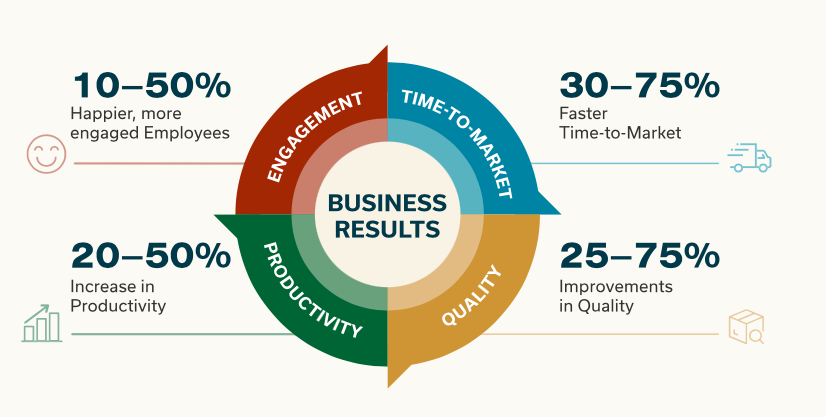Table of Contents
ToggleIn today’s fast-paced, ever-evolving business landscape, organizations are constantly seeking ways to adapt, innovate, and deliver value to their customers efficiently. To meet these demands, many have turned to the Scaled Agile Framework (SAFe), a comprehensive framework that has become the go-to solution for scaling Agile practices in large enterprises.

But how exactly does SAFe benefit organizations? Let’s explore four key areas: faster time-to-market, improvements in quality, increased productivity, and better employee engagement.
1. Faster Time-to-Market
Imagine a large software development company that previously struggled with lengthy release cycles. They decided to implement SAFe to address this issue. With SAFe, they established Agile Release Trains (ARTs), which allowed for synchronized planning and quicker feedback cycles. As a result, their time-to-market for new features and products significantly decreased.
SAFe’s PI (Program Increment) planning events, when combined with Agile Release Trains, help organizations align cross-functional teams, prioritize work, and deliver value on a regular cadence. This synchronization ensures that features and updates reach customers faster. The reduction in cycle time not only pleases customers but also allows organizations to respond swiftly to changing market conditions.

2. Improvements in Quality
A manufacturing company switched to SAFe to streamline its production processes. Through SAFe’s Lean-Agile mindset, they adopted a culture of continuous improvement and identified and resolved quality issues proactively. This led to fewer defects and enhanced product quality.
SAFe promotes a focus on quality throughout the development process. Lean-Agile principles emphasize building quality into the product from the start rather than relying solely on post-development testing. This approach reduces defects, enhances customer satisfaction, and decreases rework, ultimately saving time and resources.
3. Increase in Productivity
An IT services company embraced SAFe to boost its team’s productivity. By aligning teams and facilitating efficient communication through SAFe’s ceremonies and artifacts, they eliminated bottlenecks and saw a significant increase in the team’s velocity.
SAFe enhances productivity by providing a structured framework for collaboration, regular synchronization, and efficient communication. Teams are empowered to make decisions, and with a Lean-Agile mindset, they can identify and remove impediments quickly. This leads to increased throughput and the delivery of higher-value work.
4. Better Employee Engagement
A financial services organization wanted to enhance employee engagement in its technology department. After implementing SAFe, they observed a culture shift, with teams taking ownership of their work. This change led to higher morale, creativity, and commitment among employees.
SAFe’s emphasis on decentralized decision-making, self-organizing teams, and a culture of continuous improvement fosters a sense of ownership and engagement among employees. When teams are empowered to make choices and contribute to their projects’ success, they are more motivated, creative, and satisfied in their roles.

Conclusion
The Scaled Agile Framework is more than a framework for software development; it’s a holistic approach that transforms organizations. By enabling faster time-to-market, improvements in quality, increased productivity, and better employee engagement, SAFe empowers organizations to thrive in a competitive and ever-changing business environment. Whether you’re in IT, manufacturing, healthcare, or any other industry, SAFe can help you deliver value more efficiently, delight your customers, and engage your teams to drive success.
Ready to experience the benefits of SAFe in your organization? Start your Agile transformation journey today and unlock the potential for growth and success.
Transform Your Leadership with Leading SAFe Certification! Elevate your career and influence with the Leading SAFe certification. This program will equip you with the expertise to lead Agile transformations at scale, drive continuous improvement, and deliver remarkable results. Join the league of certified SAFe leaders who are shaping the future of Agile. Don’t let this opportunity pass you by! Enroll now and take charge of your Agile journey, leading your organization to new heights of success.
